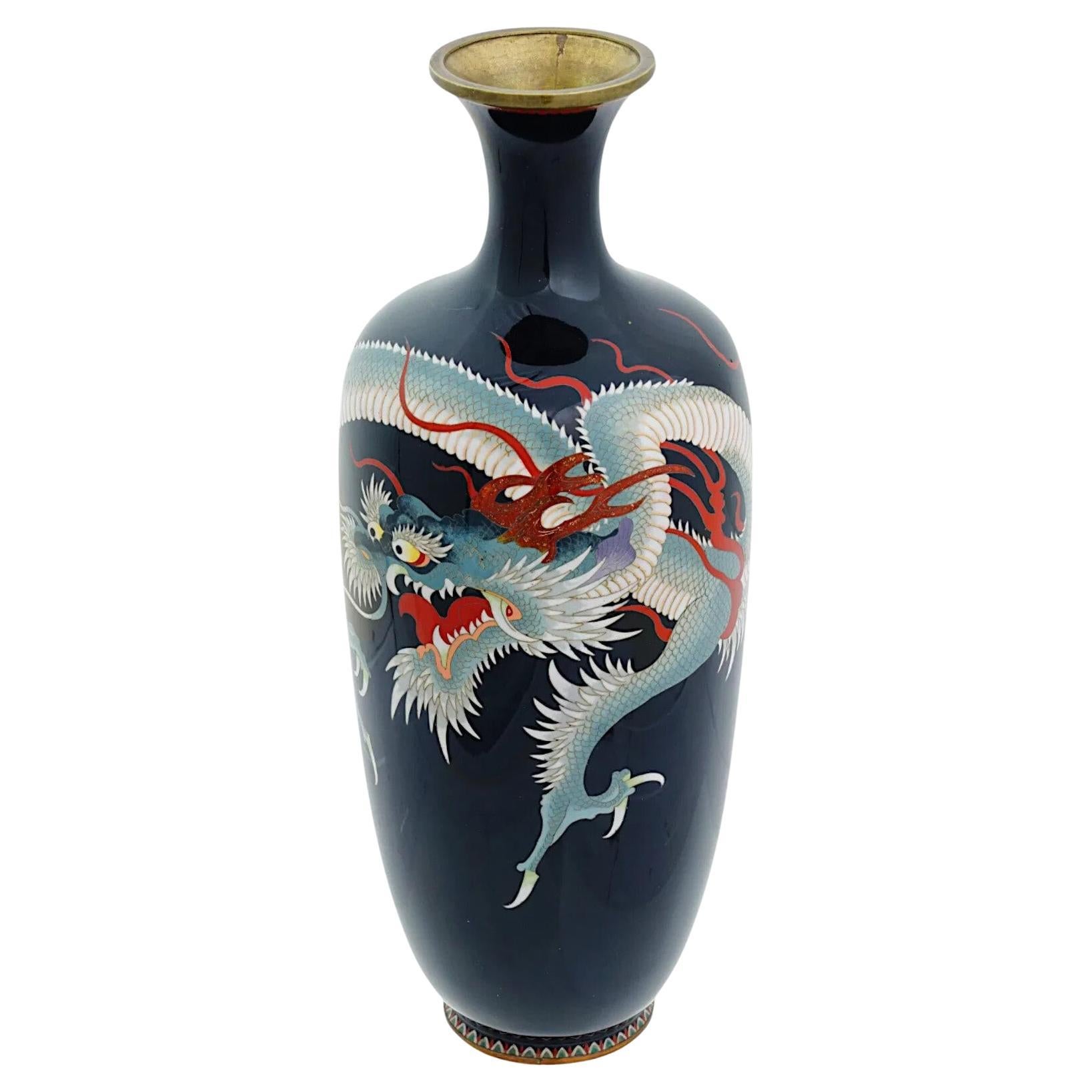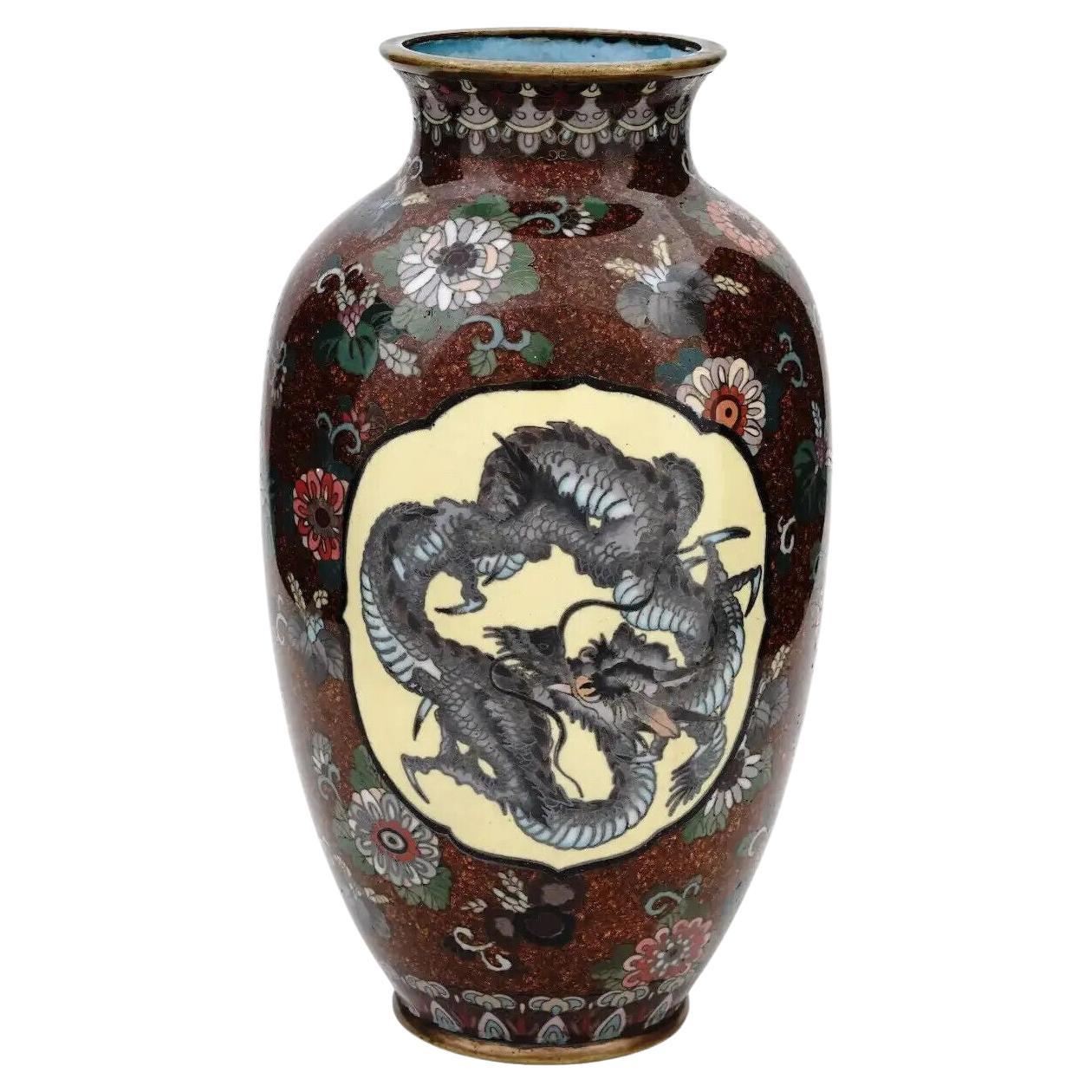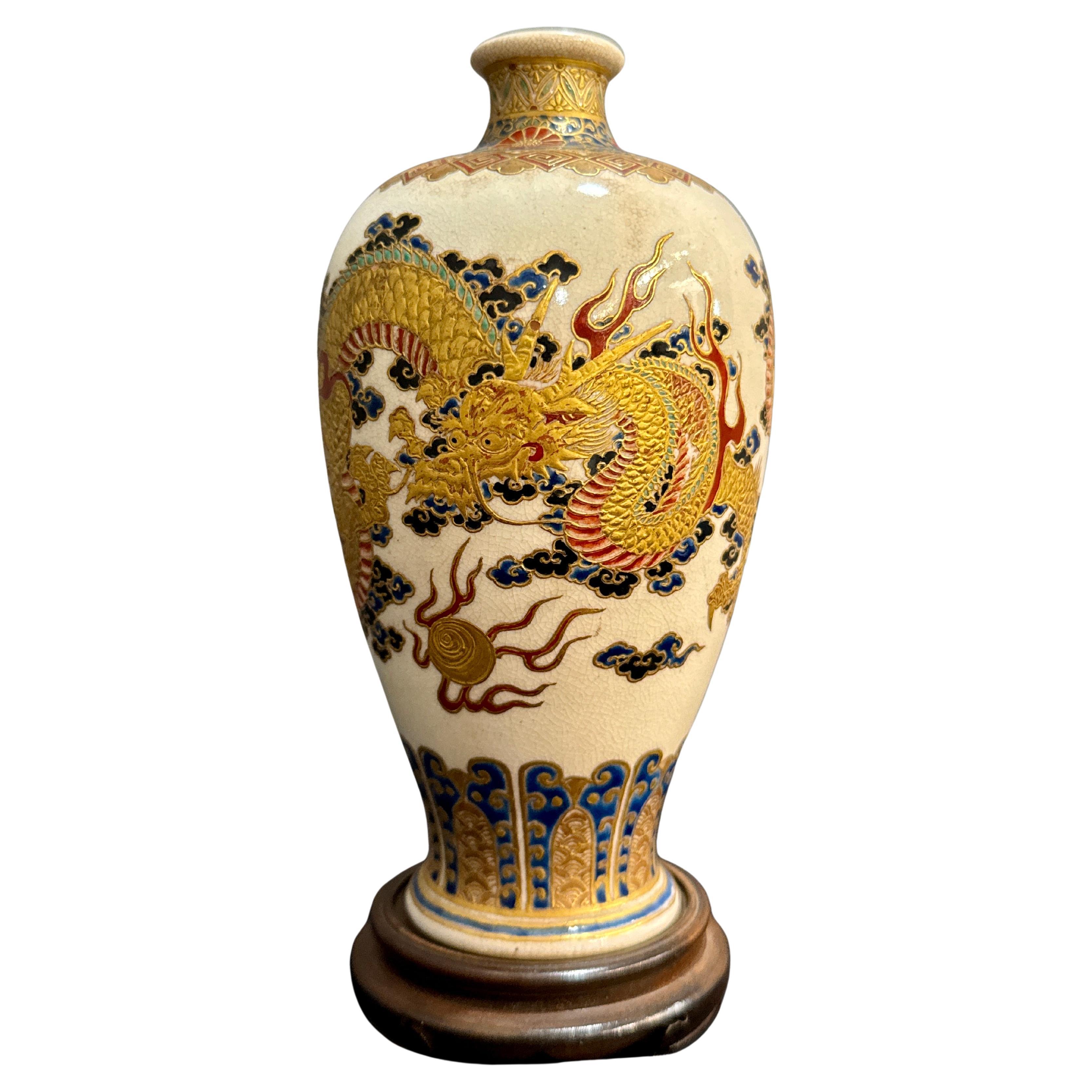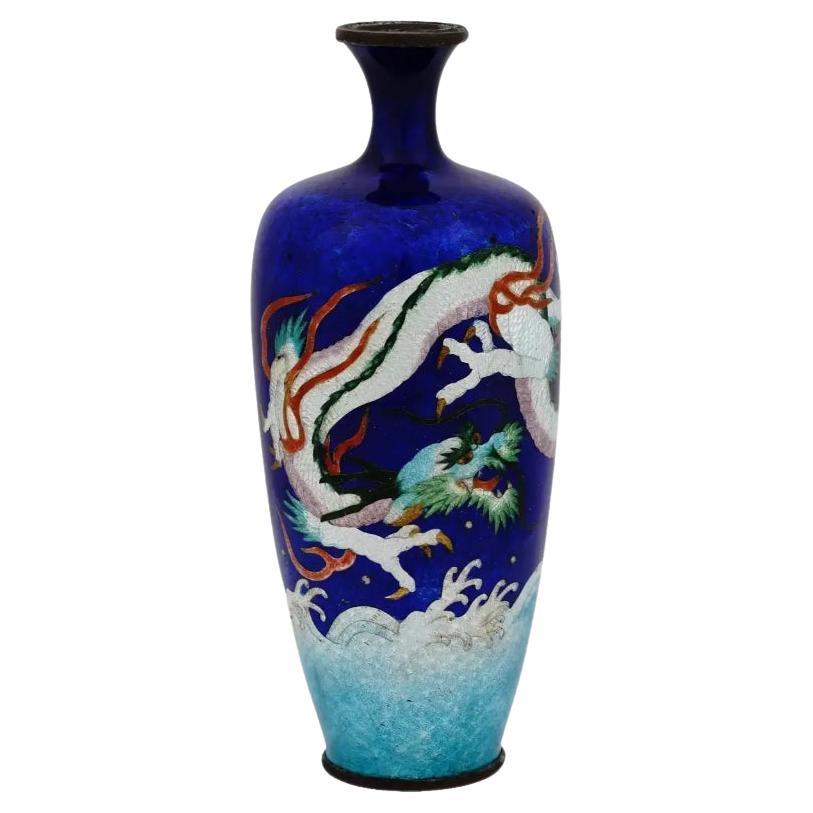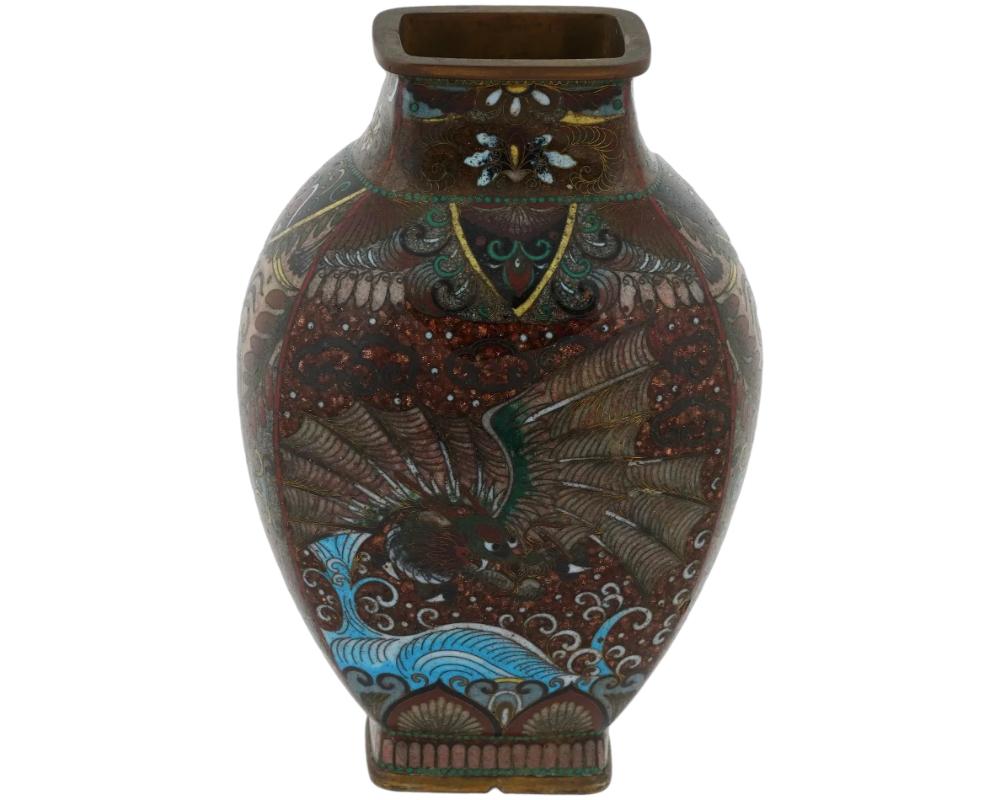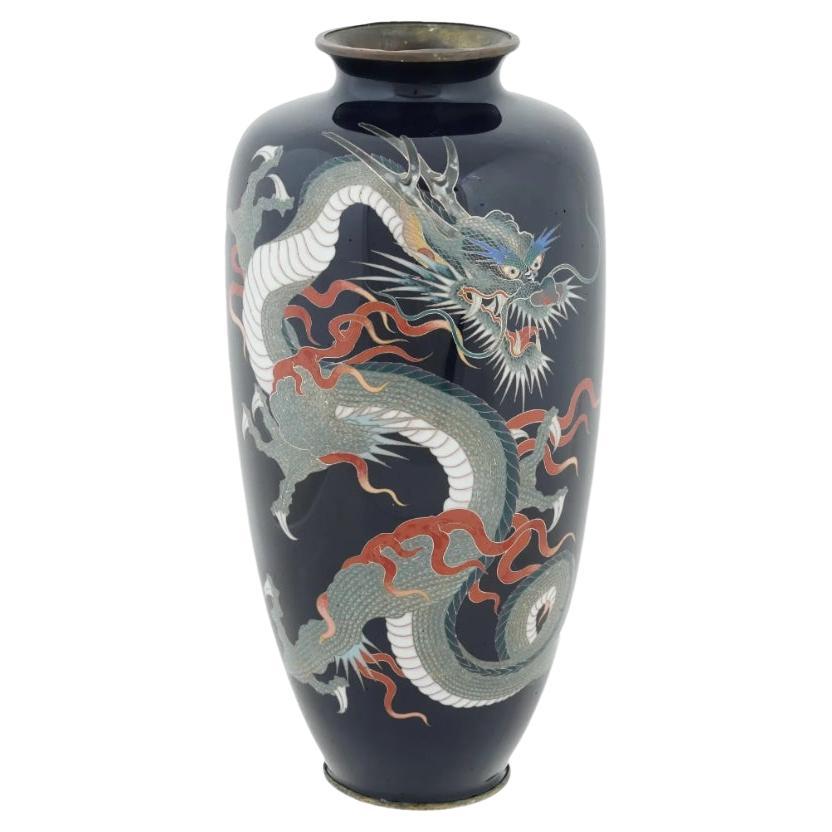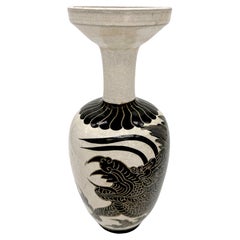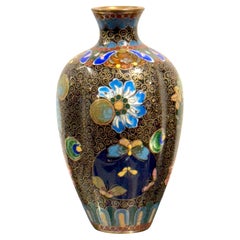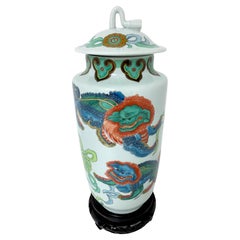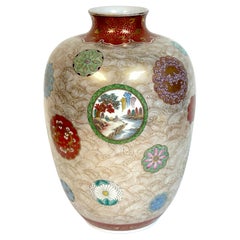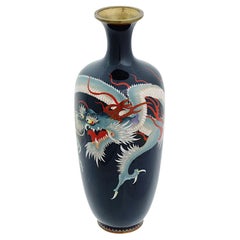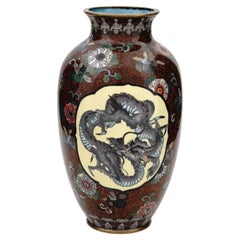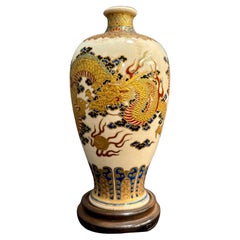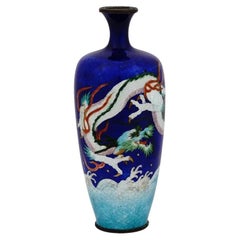Items Similar to Exquisite Japanese Wireless Cloisonné Dragon Motif Vase, Meiji / Taisho Period
Want more images or videos?
Request additional images or videos from the seller
1 of 16
Exquisite Japanese Wireless Cloisonné Dragon Motif Vase, Meiji / Taisho Period
$1,100
£830.83
€960.21
CA$1,542.92
A$1,716.12
CHF 898.18
MX$20,931.02
NOK 11,285.97
SEK 10,615.92
DKK 7,167
About the Item
Japanese Wireless Cloisonné Enamel Vase, likely from the Meiji period (1868–1912) or possibly the early Taisho period (1912–1926). The vase features a dynamic depiction of a Japanese dragon, a symbol of power, strength, and good fortune in Japanese culture.
The dragon is rendered with fine detail, showcasing intricate scales and whiskers. In Japanese mythology, dragons are water deities associated with rainfall and bodies of water, unlike their fire-breathing Western counterparts.
Cloisonné Technique: The subtle yet precise outlining of the dragon suggests a wireless cloisonné (musen shippo) or a standard cloisonné technique, where enamel is applied between fine wire compartments. This style became especially refined during the late 19th century in Japan.
Color Palette: The monochrome enamel dragon contrasts elegantly against the white enamel background, while the interior's vivid turquoise enamel adds a vibrant accent. The turquoise lining is characteristic of Japanese cloisonné vases from this era. The vase has a classic baluster form with a narrow neck and flared rim, typical of export wares during the Meiji period aimed at Western collectors. The dragon in Japanese art is often shown chasing the flaming pearl, symbolizing wisdom, prosperity, and the pursuit of perfection.
The use of cloisonné enamel flourished in Japan during the Meiji Restoration, as Japanese artisans mastered and innovated upon Chinese cloisonné techniques, creating pieces highly sought after by collectors.
Condition Report
The greenish linear inclusion visible in the cloisonné enamel is not a structural crack but rather a color bleed or firing flaw—a relatively common occurrence in early- or mid-period cloisonné work. Here’s a more technical and descriptive explanation you can use:
This linear inclusion is best understood as a glaze migration or enamel bleed, likely occurring during the high-temperature firing process. Instead of a fracture, it appears to be a subsurface flow of pigment—in this case, a green oxide (possibly copper-based) that has migrated or diffused within the white ground enamel. This can happen when adjacent enamel compartments (or cloisons) are slightly overpacked or when flux from one cell seeps under the neighboring glassy surface during kiln firing.
The result is a soft-edged streak beneath the enamel surface, with no tactile crack or separation. It often reads visually as a watermark or ink stroke, and though technically a flaw, such inclusions are commonly accepted in antique or hand-crafted cloisonné—especially in pieces where artistic spontaneity and kiln variables add uniqueness.
This mark is stable and not considered a structural issue—rather, it adds to the piece’s authenticity as a handcrafted object of its time.
- Dimensions:Height: 10 in (25.4 cm)Diameter: 4 in (10.16 cm)
- Style:Meiji (Of the Period)
- Materials and Techniques:Copper,Cloissoné
- Place of Origin:
- Period:
- Date of Manufacture:1900-1926
- Condition:Wear consistent with age and use. There is one inclusion line in the enamel.
- Seller Location:West Palm Beach, FL
- Reference Number:Seller: SDHU5T04321stDibs: LU2592322752982
About the Seller
5.0
Platinum Seller
Premium sellers with a 4.7+ rating and 24-hour response times
Established in 1996
1stDibs seller since 2017
1,417 sales on 1stDibs
Typical response time: <1 hour
- ShippingRetrieving quote...Shipping from: West Palm Beach, FL
- Return Policy
Authenticity Guarantee
In the unlikely event there’s an issue with an item’s authenticity, contact us within 1 year for a full refund. DetailsMoney-Back Guarantee
If your item is not as described, is damaged in transit, or does not arrive, contact us within 7 days for a full refund. Details24-Hour Cancellation
You have a 24-hour grace period in which to reconsider your purchase, with no questions asked.Vetted Professional Sellers
Our world-class sellers must adhere to strict standards for service and quality, maintaining the integrity of our listings.Price-Match Guarantee
If you find that a seller listed the same item for a lower price elsewhere, we’ll match it.Trusted Global Delivery
Our best-in-class carrier network provides specialized shipping options worldwide, including custom delivery.More From This Seller
View All20th Century Chinese Jizhou Kiln Style Dragon Motif Vase
Located in West Palm Beach, FL
20th-century Chinese Jizhou Kiln-Style Dragon Motif Vase
China, 20th Century Example
This 20th-century Chinese Jizhou Kiln-style dragon motif vase is a refined and elegant example ...
Category
20th Century Chinese Chinese Export Ceramics
Materials
Porcelain
$752 Sale Price
20% Off
Meiji Period Cloisonne Bulbous Cabinet Vase
Located in West Palm Beach, FL
Meiji Period Japanese Cloisonné Enamel Cabinet Vase, circa 1880
A finely detailed Japanese Meiji period cloisonné cabinet vase, dating to the late 1...
Category
Antique Late 19th Century Japanese Meiji Vases
Materials
Copper
Japanese Arita Foo dog Motif Covered Urn, with Carved Hardwood Stand
Located in West Palm Beach, FL
Japanese Arita Foo dog Motif Covered Urn, with Carved Hardwood Stand
Japan, 20th Century
A fine Japanese Arita Foo Dog Motif Covered Urn, accompanied by a carved hardwood stand, m...
Category
20th Century Japanese Ceramics
Materials
Porcelain, Hardwood
$716 Sale Price
20% Off
Meiji Fukagawa Gilded Porcelain Vase, Wave Ground & Enameled Medallions, C. 1900
By Fukagawa
Located in West Palm Beach, FL
Meiji Period Fukagawa Gilded Porcelain Vase with Wave Ground and Enameled Medallions, Japan, Circa 1900
A superb Meiji-period Japanese porcelain vase attributed to the esteemed Fuka...
Category
Early 20th Century Japanese Meiji Vases
Materials
Porcelain
Meiji Fukagawa Imari Porcelain Hexagonal Vase with Factory Silver Collar
By Fukagawa
Located in West Palm Beach, FL
Fukagawa Hexagonal Imari Porcelain Vase with Factory Silver Collar, Meiji Period, circa 1900
An exceptional Meiji-period Japanese porcelain vase attributed to the Fukagawa studio, f...
Category
Early 20th Century Japanese Meiji Vases
Materials
Sterling Silver
Massive 20th Century Chinese Archaic Style Cloisonné Covered Urn/ Censor
Located in West Palm Beach, FL
Massive 20th Century Chinese Archaic Style Cloisonné Covered Urn/ Censor
China, 20th century
A substantial example, intricately enameled in the Archa...
Category
20th Century Chinese Chinese Export Metalwork
Materials
Bronze
$3,840 Sale Price
20% Off
You May Also Like
Large Antique Meiji Japanese Cloisonne Enamel Dragon Vase Signed
Located in Long Island City, NY
A fine quality Japanese vase from the time of Emperor Meiji, 1868 to 1912. Of a baluster form with slightly lobed shoulders, the body is adorned with a finely detailed shaded cloison...
Category
Antique Late 19th Century Japanese Meiji Vases
Materials
Metal
$5,000 Sale Price
33% Off
Japanese Cloisonne Enamel Meiji Era Dragon and Phoenix Bird Goldstone Vase
Located in Long Island City, NY
A large antique Japanese Meiji era enamel over brass vase. The amphora shaped vase is enameled with polychrome medallions with a Phoenix bird and a dragon surrounded by floral, and f...
Category
Antique Late 19th Century Japanese Meiji Vases
Materials
Enamel
Japanese Satsuma Dragon Vase, Meiji Period, c 1900, Japan
By Satsuma
Located in Austin, TX
A fantastic small Japanese Satsuma vase with image of writhing dragons, Meiji Period, circa 1900, Japan.
The vase of elegant baluster form, with a slightly flared foot, slender body...
Category
Antique Early 1900s Japanese Meiji Ceramics
Materials
Ceramic, Porcelain, Pottery, Stoneware, Hardwood
Antique Japanese Ginbari Cloisonne Enamel Dragon Vase
Located in Long Island City, NY
An antique Japanese Meiji period Ginbari enamel vase. The ground of the vase is enameled in blue and cobalt blue shades. The vase is enameled with a polychrome image of a dragon over...
Category
Early 20th Century Japanese Meiji Vases
Materials
Enamel
Antique Meiji Japanese Cloisonne Goldstone Enamel Dragon Vase Attributed to Hond
Located in Long Island City, NY
Antique Meiji Japanese Cloisonne Goldstone Enamel Dragon Vase Attributed to Honda
An antique Japanese copper vase with cloisonne enamel design. Late Meiji period, before 1880.
High Q...
Category
Antique 19th Century Japanese Meiji Vases
Materials
Enamel, Copper
Large Antique Meiji Japanese Cloisonne Enamel Silver Wire Dragon Vase Signed
Located in Long Island City, NY
A large antique Japanese copper vase with cloisonne enamel design. Late Meiji period, circa 1890 Golden Age . Elongated shape with pronounced neck. Dragon motif against the dark blue...
Category
Antique 19th Century Japanese Meiji Vases
Materials
Enamel, Copper
More Ways To Browse
Antique Kilns
Bathroom Scale
Kiln Japanese
Meiji Period Vase
Japanese Dragon
1926 Vase
Antique Japanese Dragon
Antique Japanese Cloisonne Vase
Japanese Vase Marks
Japanese Water Vessel
Antique Turquoise Vase
Japan Copper Vase
Chinese Vase Dragon
Cloissone Vases
Meiji Cloisonne Vase
Chinese Vase With Dragons
Pearlized Vases
1900 Japanese Vase
